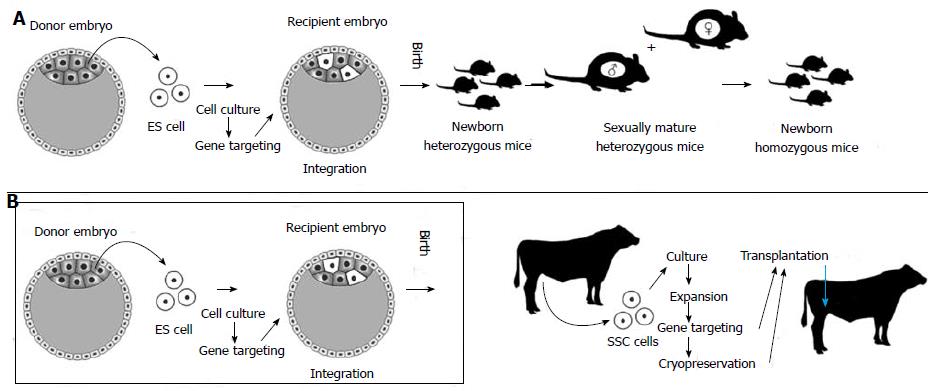Copyright
©The Author(s) 2015.
World J Stem Cells. May 26, 2015; 7(4): 669-680
Published online May 26, 2015. doi: 10.4252/wjsc.v7.i4.669
Published online May 26, 2015. doi: 10.4252/wjsc.v7.i4.669
Figure 2 Alternative ways to exploit stem cells to produce transgenic animals.
A: Standard method (well developed in the mouse): Embryonic stem cells (ES cells) are obtained from a donor mouse blastocyst. These cells are cultured and genetically modified (usually, DNA sequences are inserted on a gene of interest to disrupt its expression or gene knockout). ES cells are injected into another mouse blastocyst so that they can integrate into the embryo (chimera formation) with the hope that some of them will contribute to the male germline. In this case, donor germline cells will undergo homologous recombination (meiosis) in the testis after animals are born and develop towards puberty. The male animals will be heterozygous for the mutated gene and when crossed with their (also heterozygous) sisters, offspring will be obtained homozygous for the transgene; B: Transgenesis technique involving spermatogonial stem cells (SSCs), particularly useful for farm animals, for which ES cell technologies are not feasible. SSCs from postnatal animals can be expanded in culture, subject to gene targeting and transplanted to a recipient foreign testis. This way, steps used with ES cell technologies become redundant (Figure 2B, inside the box). With the advent of spermatogenesis in vitro, even the SSC transplantation procedure will not be necessary. Cryopreservation techniques for SSCs are already available.
- Citation: Aponte PM. Spermatogonial stem cells: Current biotechnological advances in reproduction and regenerative medicine. World J Stem Cells 2015; 7(4): 669-680
- URL: https://www.wjgnet.com/1948-0210/full/v7/i4/669.htm
- DOI: https://dx.doi.org/10.4252/wjsc.v7.i4.669









